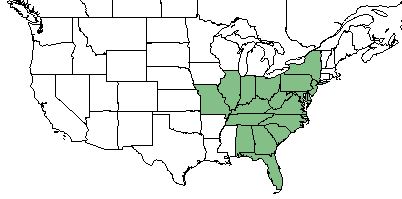Difference between revisions of "Rudbeckia fulgida"
(→Phenology) |
(→Phenology) |
||
| Line 37: | Line 37: | ||
<!--Natural communities, human disturbed habitats, topography, hydrology, soils, light, fire regime requirements for removal of competition, etc.--> | <!--Natural communities, human disturbed habitats, topography, hydrology, soils, light, fire regime requirements for removal of competition, etc.--> | ||
===Phenology=== | ===Phenology=== | ||
| − | + | ''R. fulgida'' has been observed to flower in Janurary, February, April, May, July, and September. <ref name= "Pan Flora"> Nelson, G. PanFlora: Plant data for the eastern United States with emphasis on the Southeastern Coastal Plains, Florida, and the Florida Panhandle. www.gilnelson.com/PanFlora/ Accessed: 29 MAY 2018</ref> | |
<!--Timing off flowering, fruiting, seed dispersal, and environmental triggers. Cite PanFlora website if appropriate: http://www.gilnelson.com/PanFlora/ --> | <!--Timing off flowering, fruiting, seed dispersal, and environmental triggers. Cite PanFlora website if appropriate: http://www.gilnelson.com/PanFlora/ --> | ||
<!--===Seed dispersal===--> | <!--===Seed dispersal===--> | ||
Revision as of 14:02, 6 November 2018
Common names: Orange coneflower, eared coneflower [1], black-eyed Susan [2]
| Rudbeckia fulgida | |
|---|---|

| |
| Photo by Chris Evans, University of Illinois, Bugwood.org hosted at Forestryimages.org | |
| Scientific classification | |
| Kingdom: | Plantae |
| Division: | Magnoliophyta - Flowering plants |
| Class: | Magnoliopsida - Dicots |
| Order: | Asterales |
| Family: | Asteraceae |
| Genus: | Rudbeckia |
| Species: | R. fulgida |
| Binomial name | |
| Rudbeckia fulgida Aiton | |

| |
| Natural range of Rudbeckia fulgida from USDA NRCS Plants Database. | |
Contents
Taxonomic Notes
Synonym: R. acuminata(C.L. Boynton & Beadle), R. foliosa (C.L. Boynton & Beadle), R. truncata (Small)
Variety: Rudbeckia fulgida var. spathulata (Michaux)Perdue, Rudbeckia fulgida var. speciosa (Wendroth) Perdue, Rudbeckia fulgida var. sullivantii (C.L. Boynton & Beadle), Rudbeckia fulgida var. umbrosa (C.L. Boynton & Beadle)
Description
R. fulgida is a perennial forb/herb of the Asteraceae family that is native to North America. [1]
Distribution
R. fulgida is found specifically in Florida, Georgia, South Carolina, North Carolina, Virginia, Maryland, Delaware, New Jersey, Pennsylvania, New York, Ohio, West Virginia, Kentucky, Indiana, Tennessee, Illinois, Missouri, and Alabama.[1]
Ecology
Habitat
R. fulgida is found in habitats of dry to wet meadows with some varieties found in bottomlands, bogs, moist forests and woodlands, and calcareous slopes. [3]
R. fulgida have been found in environments with loamy sand or chaulky clay, pine woods, hardwoods bording lakes, wet hammock, open limestone glade, and rocky wooded bluffs. [4]
Phenology
R. fulgida has been observed to flower in Janurary, February, April, May, July, and September. [5]
Conservation and Management
R. fulgida is considered rare in Indiana and endangered in New Jersey. [1]
Cultivation and restoration
Photo Gallery
References and notes
- ↑ 1.0 1.1 1.2 1.3 USDA Plant Database
- ↑ Davis, J., J. Eric, et al. (2002). "Vascular flora of Piedmont Prairies: Evidence from several prairie remnants." Castanea 67(1): 1-12.
- ↑ Weakley, A. S. (2015). Flora of the Southern and Mid-Atlantic States. Chapel Hill, NC, University of North Carolina Herbarium.
- ↑ URL: http://herbarium.bio.fsu.edu. Last accessed: June 2018. Collectors: Loran Anderson, Mark Garland, R.K. Godfrey, A.H. Curtis, John Nelson, Richard Houk, R. Kral, Ann Johnson, Wilson Baker, Robert Farley, Shelly Sparks. States and counties: Florida (Wakulla, Dixie, Jackson, Taylor, Gadsden, Jefferson, Charlotte) Georgia (Thomas) Alabama (Cherokee) Tennessee (Marion)
- ↑ Nelson, G. PanFlora: Plant data for the eastern United States with emphasis on the Southeastern Coastal Plains, Florida, and the Florida Panhandle. www.gilnelson.com/PanFlora/ Accessed: 29 MAY 2018